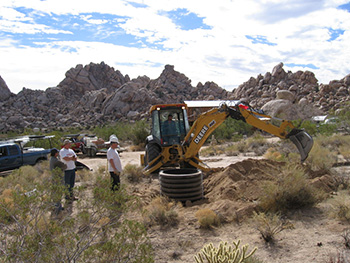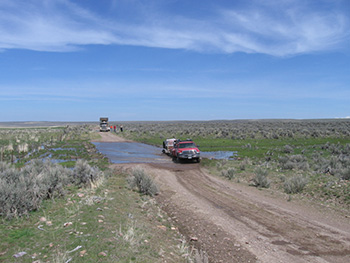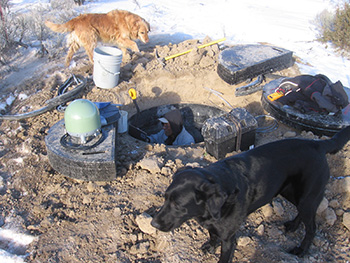S22A
4UR Ranch, Creede, CO, USA
The USArray component of the NSF-funded EarthScope project ended its observational period in September 2021 and all remaining close-out tasks concluded in March 2022. Hundreds of seismic stations were transferred to other operators and continue to collect scientific observations. This USArray.org website is now in an archival state and will no longer be updated. To learn more about this project and the science it continues to enable, please view publications here: http://usarray.org/researchers/pubs and citations of the Transportable Array network DOI 10.7914/SN/TA.
To further advance geophysics support for the geophysics community, UNAVCO and IRIS are merging. The merged organization will be called EarthScope Consortium. As our science becomes more convergent, there is benefit to examining how we can support research and education as a single organization to conduct and advance cutting-edge geophysics. See our Joining Forces website for more information. The site earthscope.org will soon host the new EarthScope Consortium website.




By Maia ten Brink
The US road system is a feat of human engineering, an extensive web of arteries supplying resources and providing access to the furthest corners of the country. If you gathered all the roads in the United States, from interstate highways down to dusty washboard lanes, and laid them side by side, they would take up an area the size of South Carolina. The Transportable Array field engineers have traveled roughly 2.5 million kilometers of those roads.
The USArray Transportable Array (TA) is a network of more than 1700 seismic stations deployed across the United States in order to record earthquakes and study Earth’s interior structure.

Construction on a seismic station site. Photo credit: Graylan Vincent
The TA field engineers construct and install those seismic stations, fix broken stations, then remove them after two-year stints. The field engineers are nomads of the interstate system. They live three weeks out of every month in hotels and play tourist in the towns and lives of the landowners who host TA seismic stations on their properties. Collectively, the field crew have slept in hundreds of hotel beds, dined alone in thousands of corner booths, and visited every single county in the United States.
They have seen a lot of mile markers and yellow line in transit between seismic stations. They’ve criss-crossed the continent dozens of times, sometimes sitting behind the wheel for an entire day in order to keep up the TA’s schedule of operations. “Driving across the Dakotas, it seems like there’s a time warp or something,” says Howard Peavey, a service technician from New Mexico who fixes malfunctioning stations.
“You’re driving past the same three bushes every hour for hours and hours, thinking it’ll never end.”
Dan Knip, a service technician who hails from Minnesota, was astonished at just how extensive the country’s network of roads turned out to be. “I suspect you could drop somebody off in the middle of the US and they would have to walk no more than 16 kilometers to bump into a road, anywhere in the country1,” he says. “The whole US is consumed by roads and agriculture. There is nothing else.”
Roads not only make remote areas accessible, they also bring infrastructure with them—gas stations, convenience stores, hotels, restaurants, and cell phone towers. It is this infrastructure that made the TA possible. The field engineers mailed spare station parts via UPS and FedEx, slept in Motel 6’s and Holiday Inns, and sent seismic data back to California and Washington via cellular networks like Verizon and AT&T. Without easy access to communication services, fuel, and lodging, they would have had to carry supplies with them for hundreds of kilometers.
Only in a few locations, like Nevada, were stations set so far from civilization that veteran station installer Bob Pierce remembers loading up on sand and supplies in Reno and spending the next two weeks working on three seismic stations. “One site, Soldier Meadow, we started off in Reno. It took an entire day just to get to the site. Sunup to sundown, going through some ungodly places. Then we had to stay in the ranch house for the night and finish the site. It took two days to finish the site. A whole lot of sites in Nevada were like that.”
“[Homogeneity] makes it easy to go from one place to another and be successful at buying hardware at an Ace Hardware or a Home Depot, get coffee at a Starbucks that will taste the same anywhere,” says Knip. “It makes travel at a high rate possible. But there is some degree of monotony to it.”

Precarious drives to get to remote stations. Photo credit: Graylan Vincent
Many people credit the interstate highways with speeding up America’s homogenization. The interstate highway system was constructed during the Cold War as an efficient transportation network for defense modeled on Germany’s Autobahn. Mass transit connected distant cities and made it easier for Americans to move between previously isolated communities, bringing familiar chain businesses and development with them.
“Most of the country is asphalt roads, truck stops, Outback Steakhouses, and Best Westerns,” says Knip. “Once in a while you run into places that are not homogenized yet, and that’s kind of cool.” In West Texas, he stopped at a restaurant “where the waitress was busy, so she asked me if I would pour coffee for the next people that came in. That was nice. Real hometown-y kind of people.” Louisiana also had its own flavor. “The canals with boats on them, the non-standard English. But pretty much the whole US is the same kind of people. Walmarts everywhere.”
How has traveling down America’s highways and byways changed the field crew’s sense of the country?
“I always thought we were one large metropolitan area,” says Knip. “But there’s really lots of open spaces—except all the open spaces are cornfields or cattle ranches… There is not much of that Yellowstone-like [wilderness] of buffalo and grizzly bear. Most of the US is cultivated.”
Peavey agrees with Knip that the United States is fairly homogenous. “I don’t think the cultural and political differences are as great as I had been led to believe as a kid growing up in Yankee Land,” says Peavey. “People up north can be pretty provincial too. I can’t claim to avoid that. I’m guilty of it too.”
The field crew did, however, observe extremes of poverty. “Down in Florida, like in Naples, the homes are castles. They are monuments to opulence,” says Knip. “You sort of get the idea that everybody in America is really wealthy, and then you see really crushing poverty… I’ve seen guys living in paper shack houses that would make you think of the Appalachians in the 1850s.” He says, “I would rethink capitalism after seeing the US.”
Some of the field engineers encountered narrow-mindedness and racist attitudes. Anthony Kim, an Asian field technician who removes TA stations at the end of their two-year deployment, recalls being ignored by an Alabaman who assumed that Kim’s Caucasian temp workers were in charge. “He blew right past me, goes up to my temps and is like, ‘Who’s the boss here?’” Kim says. “Obviously pretty prejudiced… But for every one of those, there were landowners who were like, ‘C’mon in. Are you guys hungry?’ And they’d get a sandwich for you.”
“People have been kind at levels that you’d be surprised,” says Knip. In fact, he couldn’t believe how few people became suspicious when they saw him parked along some road or opening a landowner’s fence. Only once, in “either Florida or Texas, I can’t remember which,” Knip was stopped by police while fixing a station on the grounds of a state park. “They said that the area was filled with drug traffickers bringing drugs and dropping them on the coast, and that the police officers did not trust anyone not to be associated with the cartels.” Knip showed the officers his TA reconnaissance report, documents containing permission to work on the station. Forty-five minutes later, after questioning him at length and listening to an explanation of the Transportable Array project, they let him go.
Ultimately, the TA has depended on the kindness of strangers who were willing to spare a corner of land to host a seismic sensor.

Doan Nguyen installing Station K15A while the landowner's dogs look on.
Photo credit: Graylan Vincent
Landowners have trusted the field engineers to work freely on their properties and have invited them into their homes, offered them coffee, struck up conversations, and taken them shooting. Sometimes, landowners can be downright insistent; one woman in Texas refused to let field engineer Dean Lashway and his construction team leave without sampling her homemade tortillas.
In exchange for the hospitality, the crew occasionally fills a few holes or pulls out shrubs with the backhoe if landowners request it. They also trade knowledge, providing pamphlets and pointing landowners to websites that show what kinds of scientific research have come out of the TA’s earthquake recordings as a result of their generosity.
“TA has succeeded because the continental US has good transportation and communication infrastructure,” says Peavey. “[We] have been able to flit around the array and concentrate on the task du jour, not the elements of human existence.”
The TA’s next phase, seismic stations laid out in an evenly spaced grid across Alaska, will face a challenging wilderness with “virtually no infrastructure,” Peavey says. “Few roads. No communication system… The project has to move people, equipment, information, food, shelter, and safety with diesel or turbine fuel.” It will be a test of the TA field crew’s ingenuity and hardiness as the they pit themselves against Alaska’s uncolonized and unforgiving landscape.
____________
1 Knip’s estimation is spot on; according to a report by the US Geological Survey, any location in the Lower 48 is at most 20 kilometers from some kind of road.